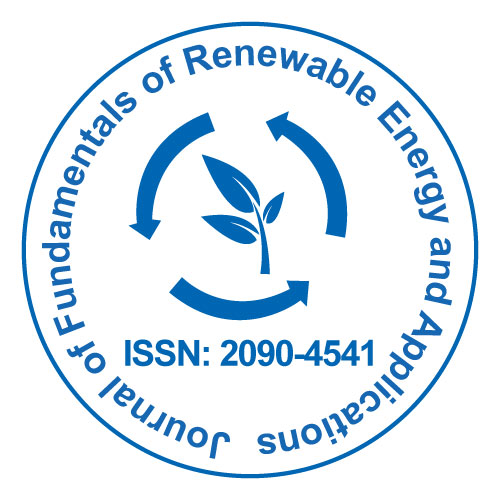
Journal of Fundamentals of Renewable Energy and Applications
Open Access
ISSN: 2090-4541

ISSN: 2090-4541
Short Communication - (2024)Volume 14, Issue 2
As the world transitions towards a more sustainable energy future, renewable energy sources such as solar, wind, and hydroelectric power are playing an increasingly significant role in electricity generation. However, integrating renewable energy into existing power systems presents several challenges, including variability, intermittency, and mismatch between supply and demand. Power electronics technologies offer solutions to address these challenges by enabling efficient, reliable, and flexible integration of renewable energy sources into the grid. This study explains the role of power electronics technologies in facilitating the integration of renewable energy and discusses various applications, benefits, and advancements in this field [1-3].
Renewable energy sources such as solar and wind power exhibit variability and intermittency due to factors such as weather conditions, diurnal cycles, and seasonal changes. This variability can lead to fluctuations in power output, posing challenges for grid stability and reliability. Renewable energy systems often generate electricity at different voltage and frequency levels than conventional power sources, requiring advanced grid interconnection technologies to ensure seamless integration into the existing power infrastructure. The intermittent nature of renewable energy sources can affect power quality and grid stability, leading to voltage fluctuations, frequency deviations, and harmonic distortions. Addressing these issues is essential to maintain grid reliability and ensure the quality of electricity supply. Effective management and control of renewable energy systems are critical for optimizing energy production, minimizing curtailment, and maximizing grid integration. Advanced control algorithms and power electronics devices are essential for achieving efficient and reliable operation of renewable energy systems [4].
Grid-connected inverters play a important role in converting DC power generated by renewable energy sources (such as solar panels or wind turbines) into AC power that is synchronized with the grid. These inverters use power electronics devices such as Insulated Gate Bipolar Transistors (IGBTs) or Silicon Carbide (SiC) to efficiently convert and control the flow of electricity between the renewable energy system and the grid. Voltage source converters are advanced power electronic devices used in High-Voltage Direct Current (HVDC) transmission systems and grid interconnection applications. Energy storage systems, such as batteries, pumped hydro storage, and flywheels, play a vital role in mitigating the variability and intermittency of renewable energy sources. Power electronics converters are used to interface energy storage systems with renewable energy systems, allowing for efficient energy storage and discharge as needed to balance supply and demand on the grid. Power conditioning systems, including voltage regulators, reactive power compensators, and harmonic filters, are used to improve power quality, voltage stability, and grid compatibility of renewable energy systems. These systems utilize power electronics devices to control voltage levels, compensate for reactive power, and filter out harmonics, ensuring reliable and stable operation of renewable energy systems. Microgrids are small-scale electricity distribution systems that can operate independently or in parallel with the main grid. Power electronics-based microgrid controllers play a important role in managing energy flow, optimizing power generation and consumption, and maintaining grid stability within microgrid systems, especially in remote or off-grid areas powered by renewable energy sources [5].
Power electronics technologies help improve grid stability and reliability by providing fast response times, voltage regulation, and reactive power compensation, thereby mitigating the impact of renewable energy variability on the grid. Advanced power electronics devices enable higher levels of renewable energy penetration into the grid by facilitating efficient grid integration, reducing curtailment, and maximizing the utilization of renewable energy resources. Power electronics-based power conditioning systems help improve power quality by regulating voltage levels, compensating for reactive power, and filtering out harmonics, ensuring a stable and reliable electricity supply from renewable energy sources. Power electronics technologies offer flexibility and adaptability in renewable energy systems, allowing for dynamic control of power flow, voltage regulation, and energy management to accommodate changing grid conditions and demand patterns. Advances in power electronics devices and control algorithms have led to cost reductions and efficiency improvements in renewable energy systems, making them more economically viable and competitive compared to conventional power sources [6-10].
Power electronics technologies play a vital role in enabling the efficient, reliable, and flexible integration of renewable energy sources into the grid. By facilitating grid synchronization, power conversion, energy management, and grid stabilization, power electronics devices help address the challenges associated with renewable energy variability and intermittency, thereby accelerating the transition towards a more sustainable and resilient energy future. Continued research, innovation, and deployment of power electronics technologies are essential for maximizing the potential of renewable energy and achieving a low-carbon and resilient energy system.
[Crossref] [Google Scholar] [PubMed]
[Crossref] [Google Scholar] [PubMed]
[Crossref] [Google Scholar] [PubMed]
[Crossref] [Google Scholar] [PubMed]
[Crossref] [Google Scholar] [PubMed]
[Crossref] [Google Scholar] [PubMed]
[Crossref] [Google Scholar] [PubMed]
[Crossref] [Google Scholar] [PubMed]
[Crossref] [Google Scholar] [PubMed]
[Crossref] [Google Scholar] [PubMed]
Citation: Jennifer L (2024) Power Electronics to Improve Grid Stability in Renewable Energy Sources. J Fundam Renewable Energy Appl. 14:350.
Received: 03-Jun-2024, Manuscript No. JFRA-24-31811; Editor assigned: 05-Jun-2024, Pre QC No. JFRA-24-31811 (PQ); Reviewed: 19-Jun-2024, QC No. JFRA-24-31811; Revised: 26-Jun-2024, Manuscript No. JFRA-24-31811 (R); Published: 03-Jul-2024 , DOI: 10.35248/2090-4541.24.14.350
Copyright: © 2024 Jennifer L. This is an open-access article distributed under the terms of the Creative Commons Attribution License, which permits unrestricted use, distribution, and reproduction in any medium, provided the original author and source are credited.